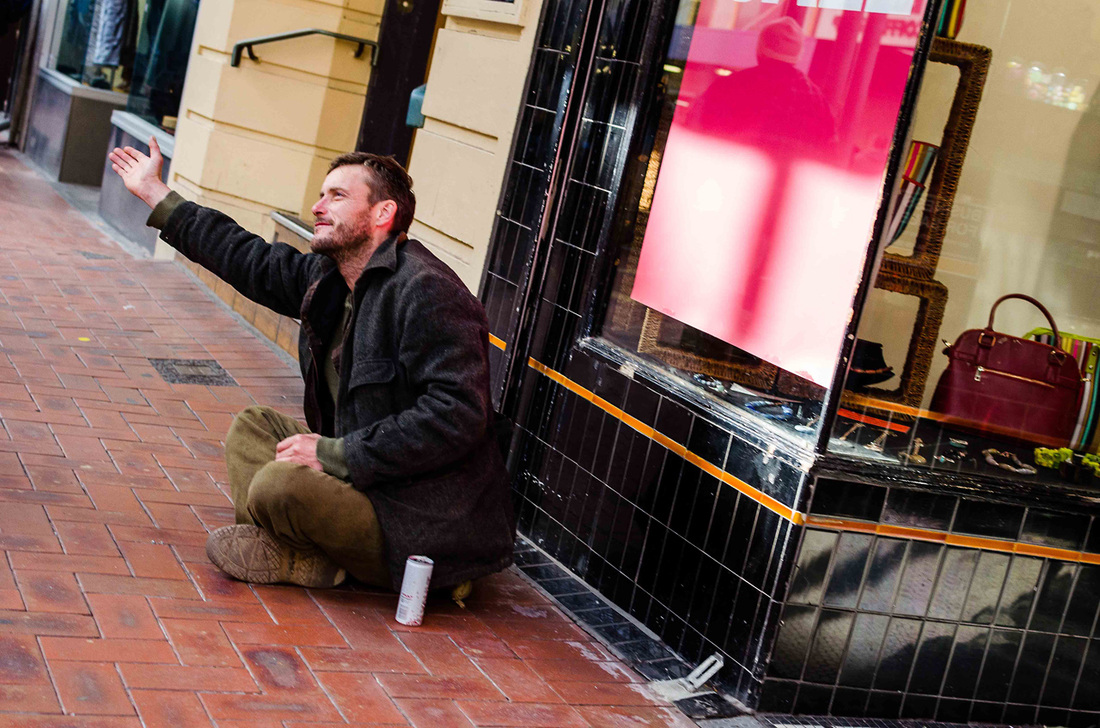|
Sorry, I missed a week. It was very busy in the gallery with the installation of Megan Campbell Newby's exhibition. BTW check out TV3 Nightline tonight for a story on it (or the item may run on Monday night, 11th Nov., depending on other news story programming). (Here's the story, which did run on Friday night. Strangely there is no mention of the name or location of the exhibition!) Also, on Saturday 9th November at 1pm, at Photospace Gallery, there is a gallery talk about Megan's exhibition What's in it for me? and the ethical considerations of the inclusive documentary photography process behind it. Megan, Erna Stachl and Dick Whyte will talk. Come along, and feel free to ask questions. Admission is free. Exhibition info Today's photo: the gesture of reaching out to a stranger (presumably for money) and the stranger's non-response (visible in the reflection of the red area of the window) is all caught with precision and strong composition (leading lines, etc). It looks 'shot from the hip' but is deliberately framed. This photograph prompts us to question our normal response to the people we make invisible, those we do not wish to include in our construction of reality. There is of course also the element of There but for the grace of God go I. It is the decisive moment - the best time to take the photograph, when all of the elements align in the frame in an effective way. And in order to communicate with photography we have to get the technical and formal stuff right, otherwise no one will bother to look at it. One of my early photography influences, and the first New Zealand one, was Wellington-based photographer Peter Black. In 1986 I came across his book Fifty Photographs (National Art Gallery, Wellington, 1982) in a second hand bookshop in the Cubacade (Ferret?). It was a signed copy, $5.00. Score! I had made a darkroom and was already trying to do black & white street photography a la Henri Cartier Bresson, Garry Winogrand Robert Frank and Andre Kertesz, and now here was someone local with a great eye and unique world view. I tried to emulate it. Much more recently, Hans came into Photospace and saw and liked Peter Black's book I loved you the moment I saw you. Follow link and scroll down a little way).
Clearly, Peter's photography (now colour and digital) has influenced Hans's, but the younger photographer (who is a TV cameraman in his day job) is very much in the process of developing a personal vision. (I'm working up to it.talking about some Peter Black photos in upcoming Friday Photo slots.) Looking at this and other street photos, it all looks easy enough: you were just lucky to be there at the time that happened; I would've taken it if I'd been there; you must've set that up; it's obviously Photoshopped. No, no, no it ain't. It takes skill, dedication, tenacity, and a willingness to engage with the world extra deeply and to learn how to see stuff that others don't bother to notice, or choose to not see. People are increasingly blinkering their experience of place and time by constantly engaging with the internet and cocooning themselves with music, so what Peter Black, Hans and others do is becoming even more vital. It is also becoming threatened by the trend towards perceived invasion of privacy - see The Friday Photo #3 What Hans does is walk around and observe stuff - moments of sadness and futility, or just plain funny, quirky things - the bizarre, the ironic, the iconic, the juxtaposed - and photograph it. Street photography is about the human condition; it is very local but also universal. In order to be a street photographer, you have to always have your camera with you (obviously, but many would-be photographers can't be bothered carrying the thing, to their shame); know how to use it without shagging about with the controls (always have the camera primed and ready for the shot, safety off); and go out a lot, in all weather (today, for instance); and develop your eye; engage, be sharp, notice stuff; and for f___s sake don't have music playing in your ears. You have to be fully present, totally in the moment. Developing your eye can be done in the library and/or art gallery as well as in the field; in fact looking at other photographers' work, as well as engaging in a wider study and enjoyment of in the visual arts, is vital for a photographer. Don't be afraid to emulate; it will come out looking different anyway, and eventually your photos will be recognisably your own. All of the good street photographers I know have distinct styles, their own concerns, and different ways of looking at the world. (See links below.) In this blog series I've talked a lot about print quality and photographic prints as unique objects. The photograph above, though, doesn't yet exist as a print (except as a 10x15cm work print maybe) because it hasn't been exhibited. Currently it's just an array of pixels on various storage devices. We are planning to show Hans's work in Photospace Gallery in 2014 and this photograph will most likely be in the exhibition. He's working on pigment printing at the moment. Hans Weston on Facebook Also, see the websites of these Wellington photographers: Further reading: On Documentary Ethics, by Greg Halpern (Thanks Peter Black, for the link.)
0 Comments
|
AuthorPhotography Matters II Categories |


 RSS Feed
RSS Feed
